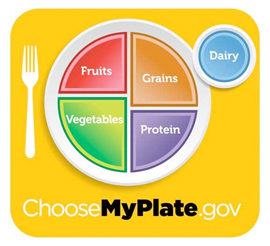 New USDA (United States Department of Agriculture) Regulations for School Meals
New USDA (United States Department of Agriculture) Regulations for School Meals
For the first time in nearly two decades, the federal government has issued new nutrition standards for meals served to America’s school children. These regulations are based on the most current Dietary Guidelines for Americans. For more information on the Dietary Guidelines, visit choosemyplate.gov.
In Newburyport, we have been ahead of the curve in school nutrition with offering nutrient rich foods including whole grains, lean sources of protein, unlimited helpings from our fresh fruit and vegetable bars and low-fat and fat-free milk. As a result of the new regulations, your student might notice some changes in the school cafeteria this year. These changes are a result of meeting very specific standards; new requirements listed below.
The new requirements include strict limits on the calories, saturated fat, trans fat and sodium in school meals. We are meeting these nutrition standards by offering students a selection of low-fat and fat-free milk, larger portions of colorful fruits and vegetables, and a variety of whole grains and lean protein choices. All lunches include five meal components:
- a meat or meat alternate such as yogurt, lean beef, chicken or low-fat cheese
- a grain such as whole-wheat bread or brown rice
- a fruit selection including an array of fresh fruits, dried fruit or canned fruit in natural juice
- raw or cooked vegetables in a variety of colors
- low-fat white, fat-free white or fat-free chocolate milk selections.
Each child must select at least three of these five components to make a meal, including a fruit or vegetable. The biggest change is that children must select a fruit or a vegetable with their lunch every day. Without a vegetable or fruit, students will not be eligible for a free or reduced reimbursable meal and will be charged for a school lunch.
Our school district will be encouraging students to try the new foods being offered this year. We are also asking for your help. Please explain these changes to your child before they arrive at school. Every student needs to be prepared to select at least one fruit or vegetable with their lunch every day. We are planning our menus to include selections we know students like, as well as many different foods they may not have tried before. Please encourage your child to try these new foods. They just might find a new favorite!
Additional Information Regarding USDA Regulations
New Regulation
- The USDA is required to update school meals regulations to bring them in line with the most recent Dietary Guidelines for Americans
- These new school meal regulations will start in the 2012-2013 school year
- Further changes to both breakfast and lunch will be required in following years (2013-2014 and 2014-2015).
- In July 2010, Chartwells proactively established our own food and nutrition guidelines with the objectives of promoting student health through our ingredients, menus, and practices.
- Chartwells has already incorporated many of the new regulations into our current menus.
Increase in Fruits and Vegetables
- Fruits and vegetables are now separate meal components and each must be offered at each lunch at all grade levels.
- The new regulations require schools to offer a variety of nutrient-dense vegetables over the course of the week, including specific amounts for dark green, orange, starchy vegetables and legumes (beans).
- Students will now be required to take 1/2 cup of fruit or vegetable for their meal to be reimbursable.
- Requiring a greater quantity and variety of fruits and vegetables will expose students to more nutrient-dense foods that are a part of a healthy diet.
- Colorful fruits and vegetables provide essential vitamins and minerals important for growth and development during childhood.
Allowable Grains and Proteins
- Menus must offer specific amounts of grains and proteins throughout the week, but cannot exceed maximum amounts defined for each grade group.
- This means we are now limited in the amount of grains and proteins we offer at each meal.
- These changes are intended to make sure students are receiving age-appropriate, nutritionally-adequate meals that provide the right amount of energy from healthful food sources.
- Half of the grains offered at lunch each week must be whole grain rich.
- By school year 2014-2015, only whole grain rich foods will be allowable in both the breakfast and lunch programs.
- Whole grain foods are part of a healthy diet and recommended by the Dietary Guidelines for Americans.
- Whole grains provide fiber, energy, vitamins, and minerals – all of which are necessary for maintaining health and preventing chronic disease.